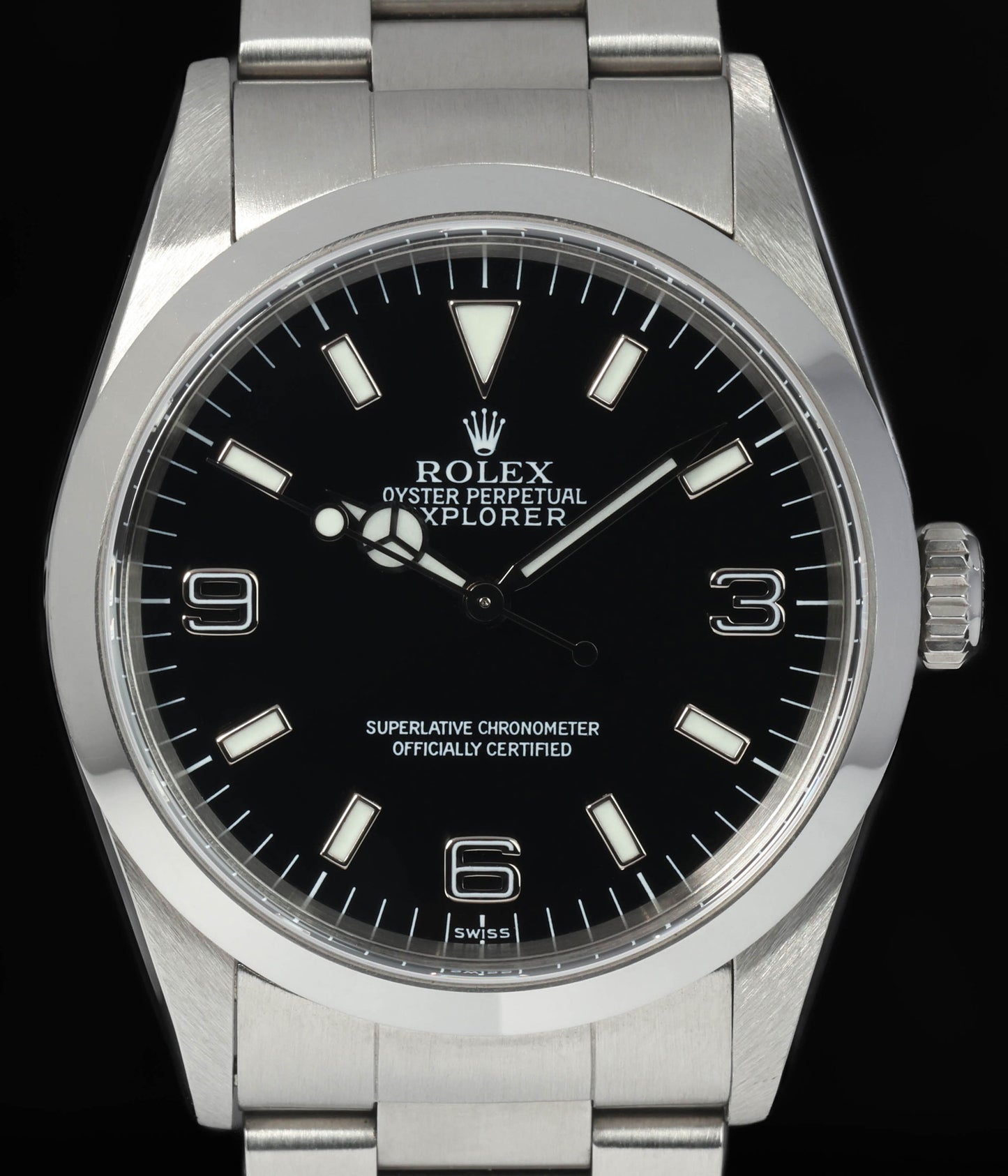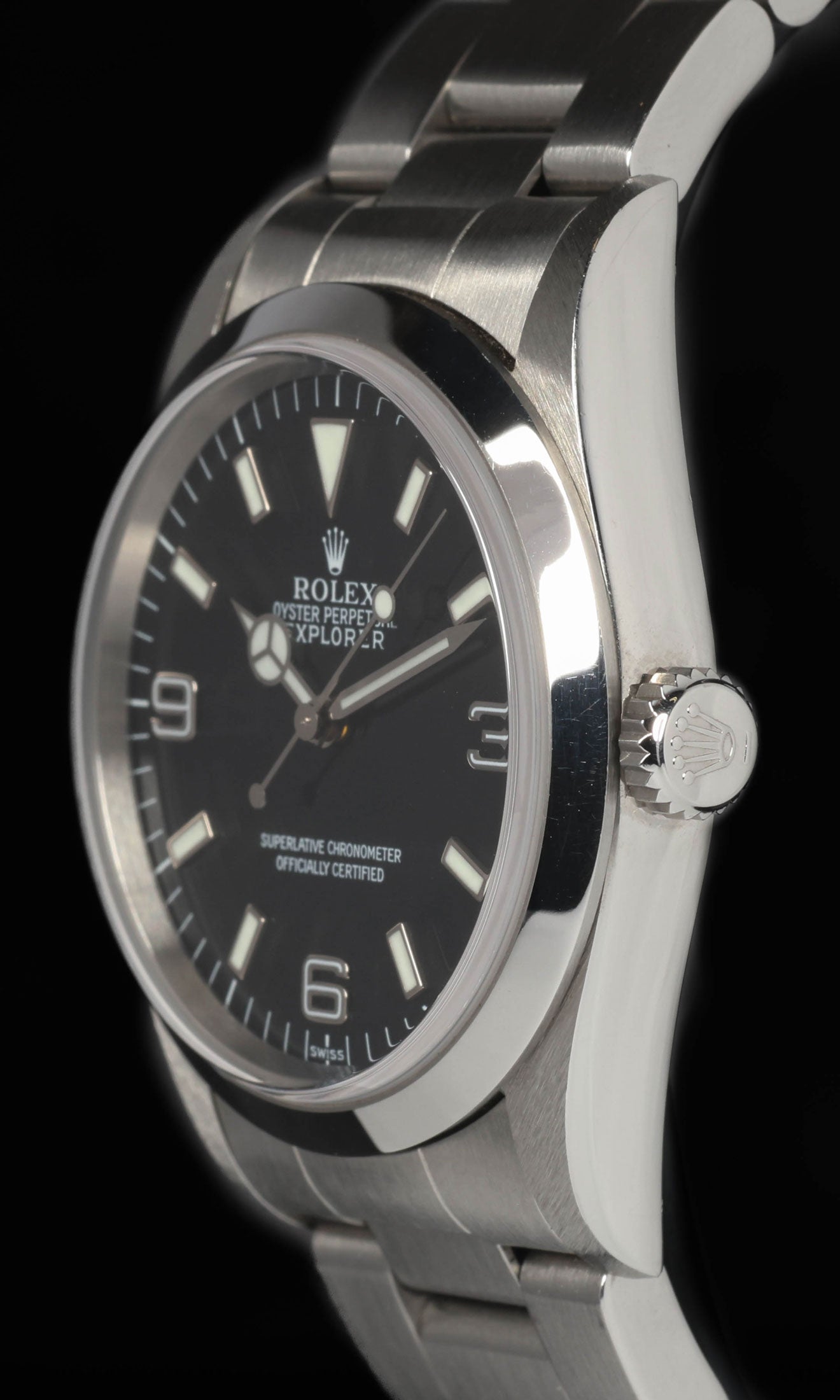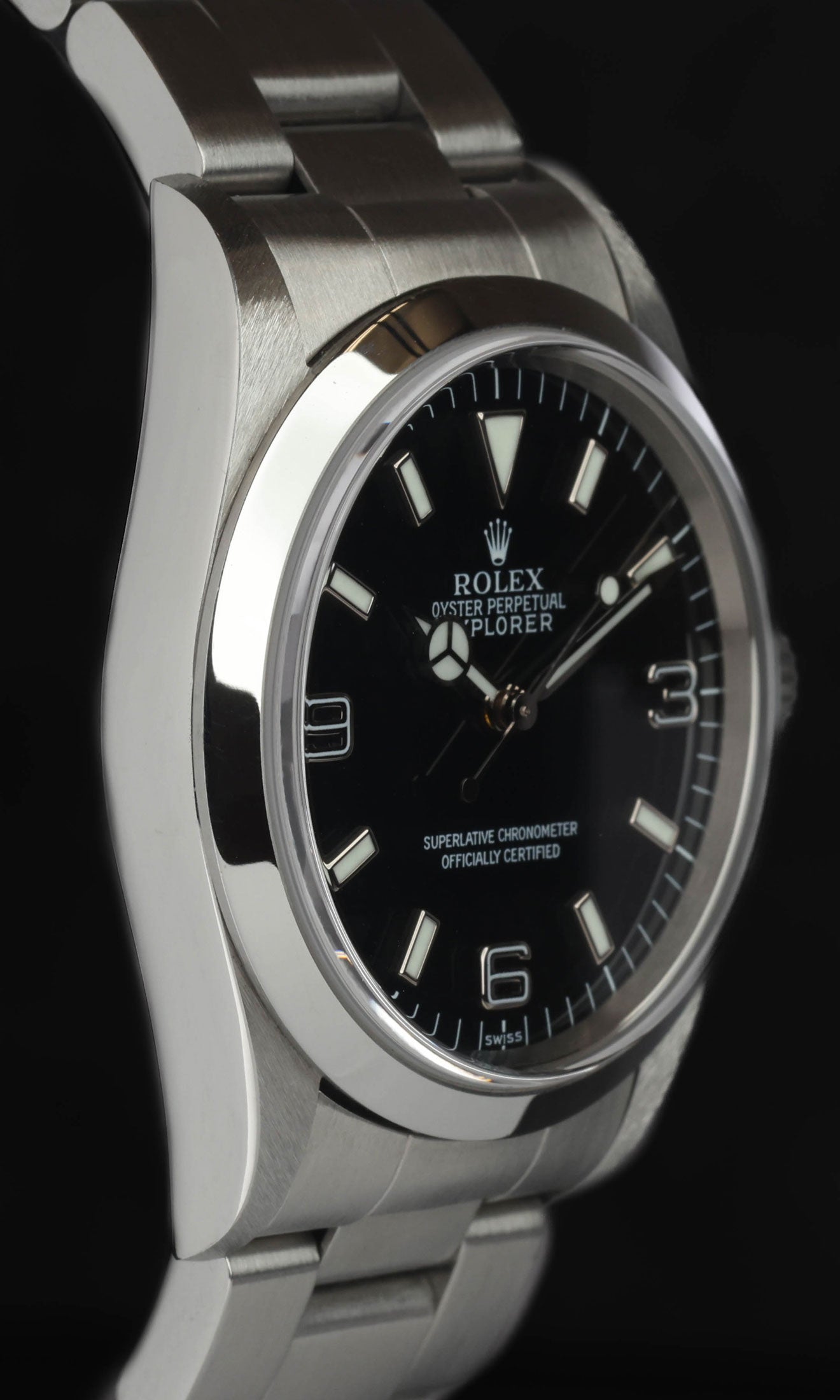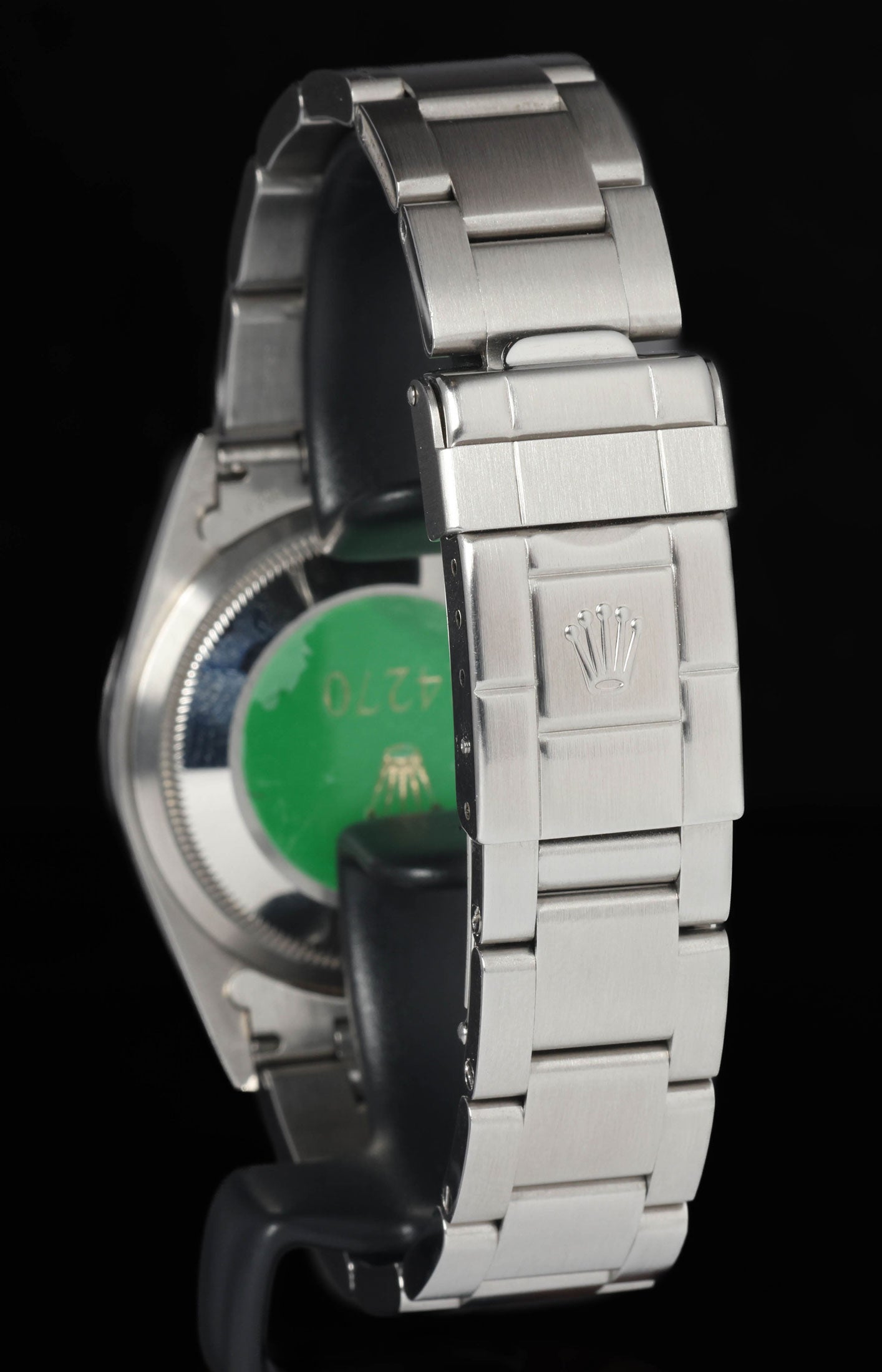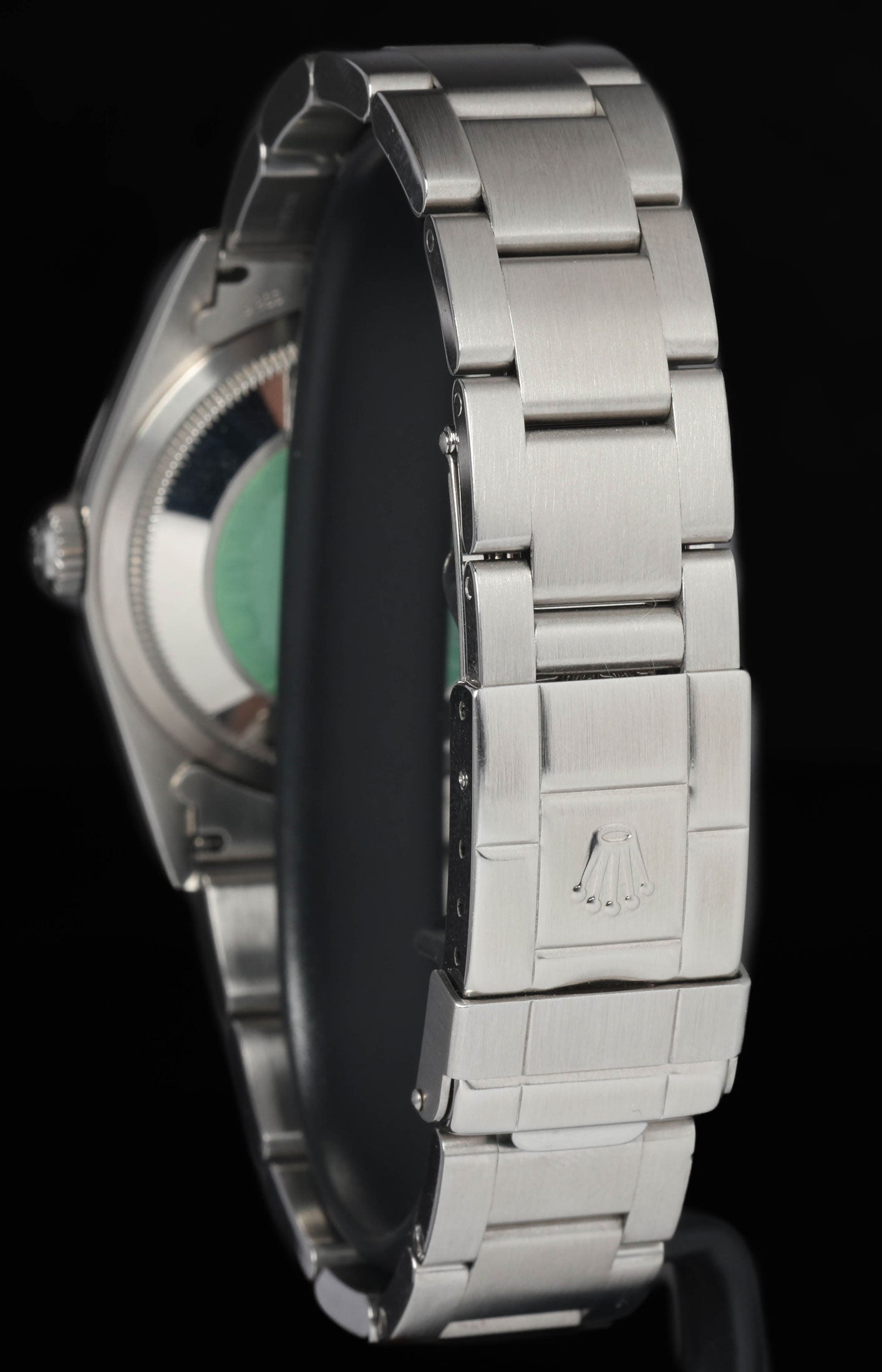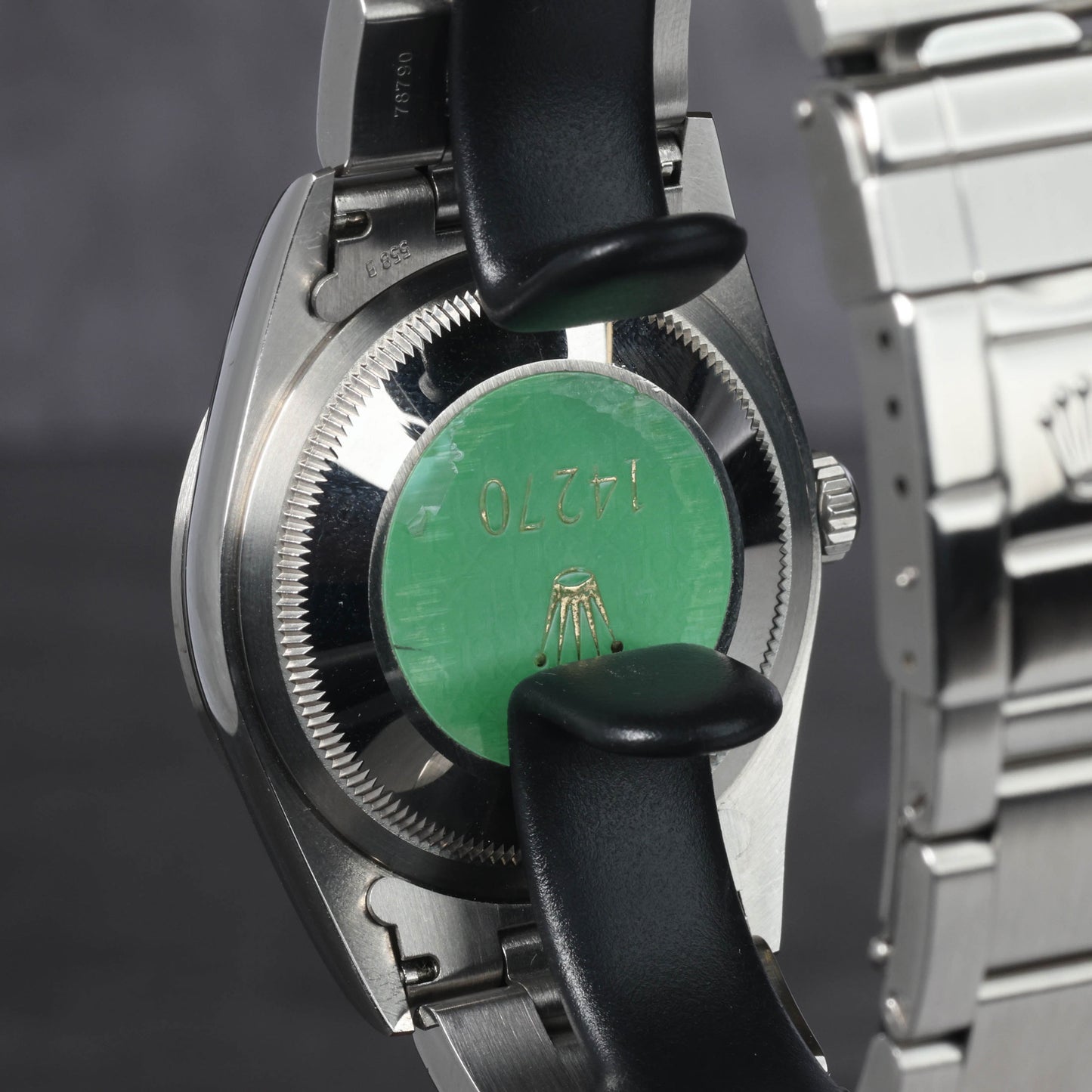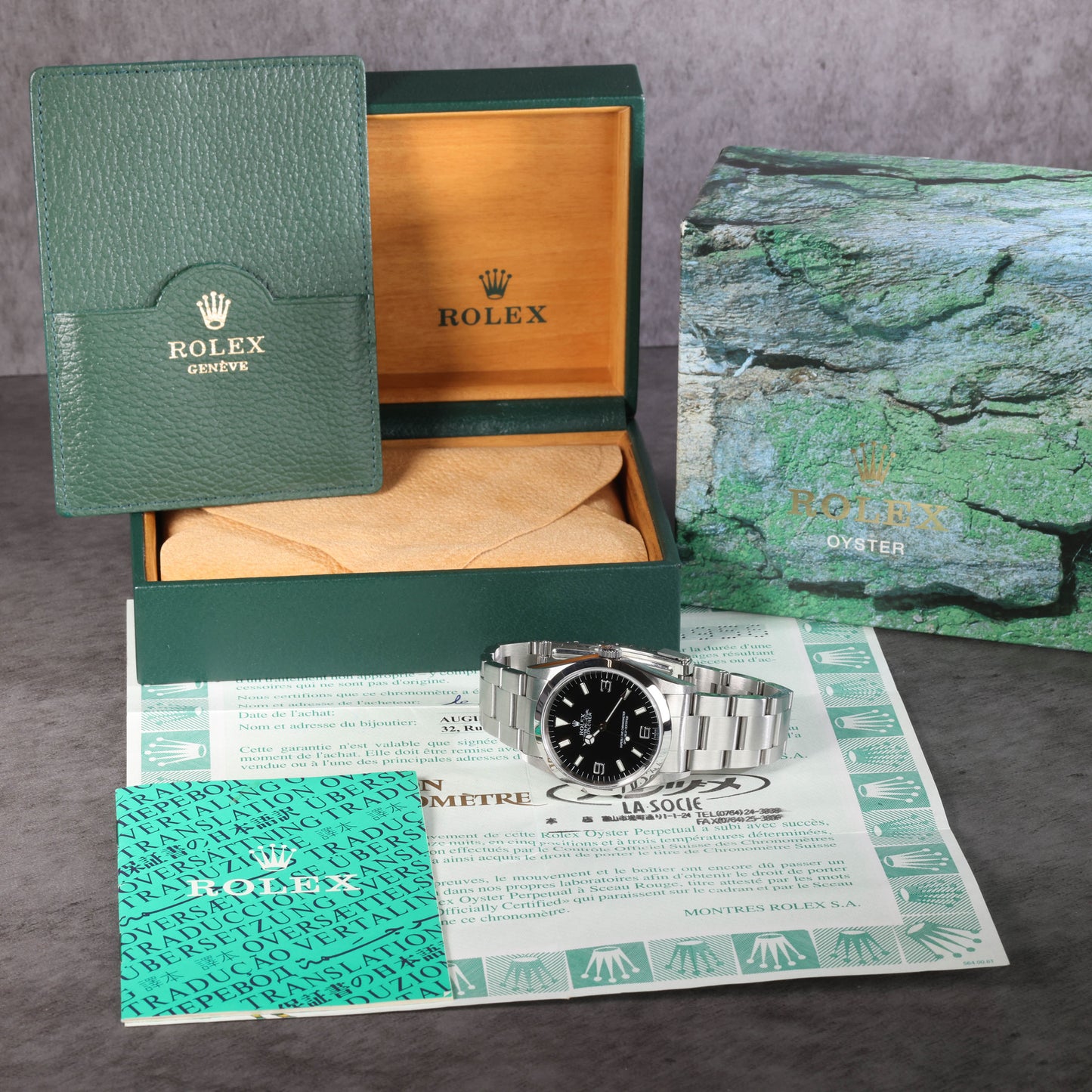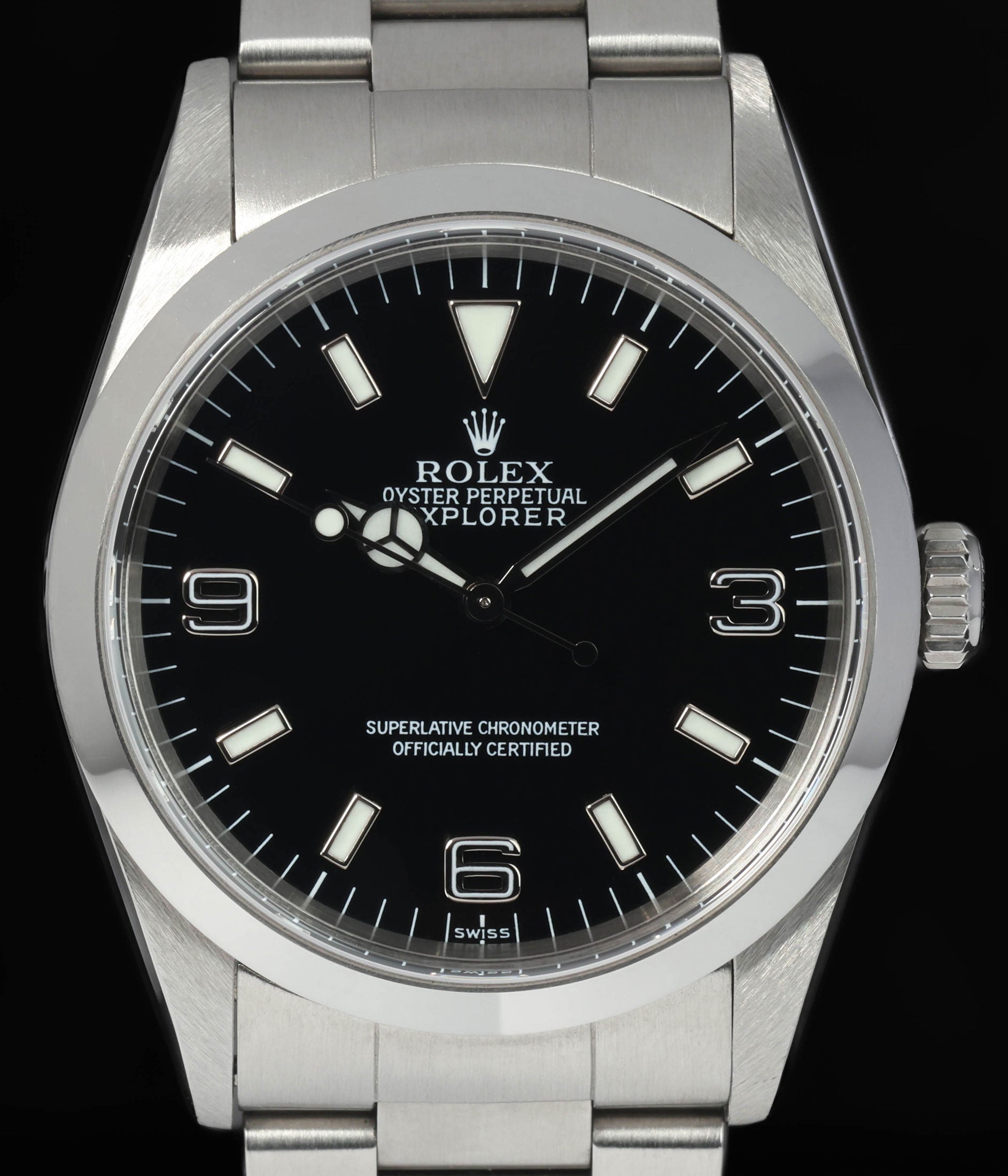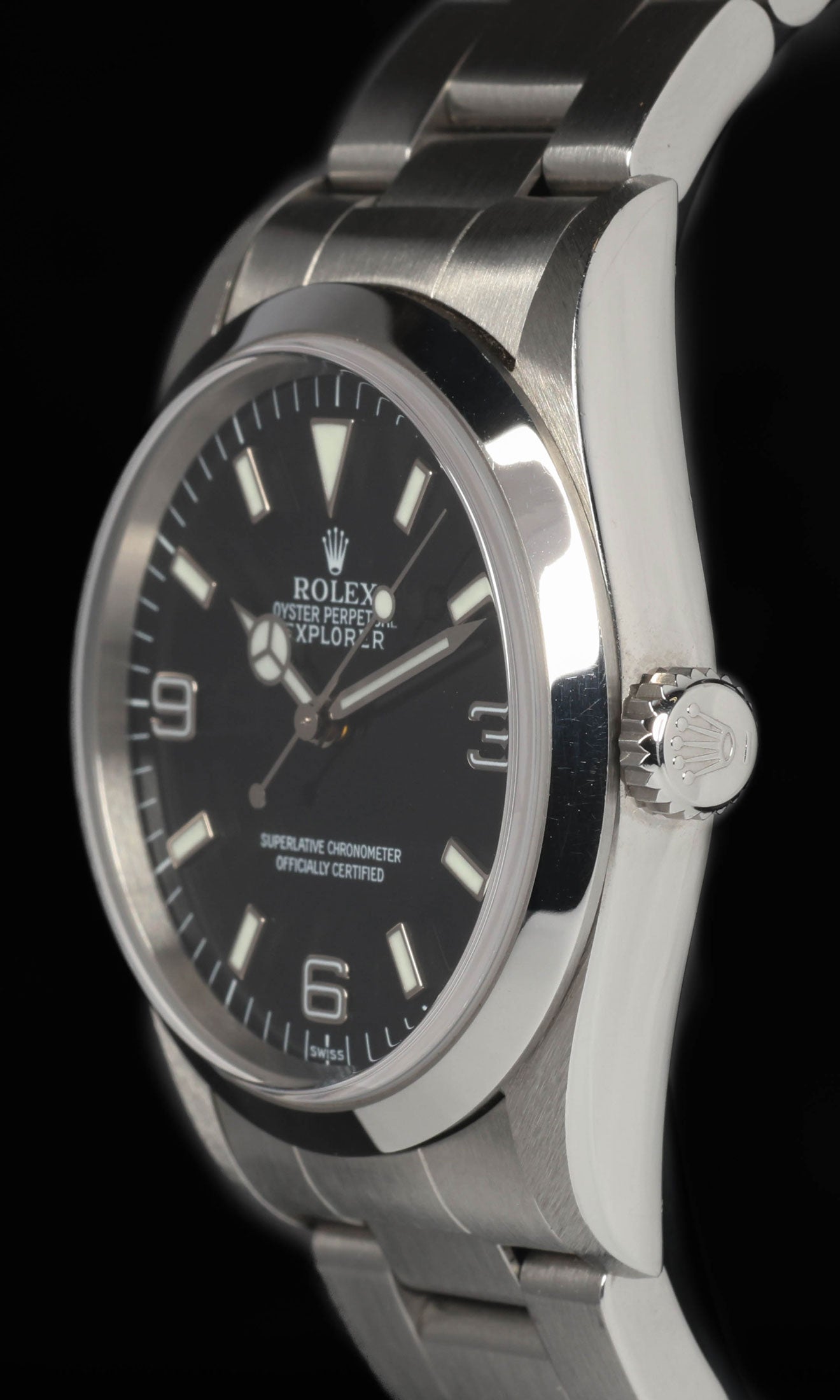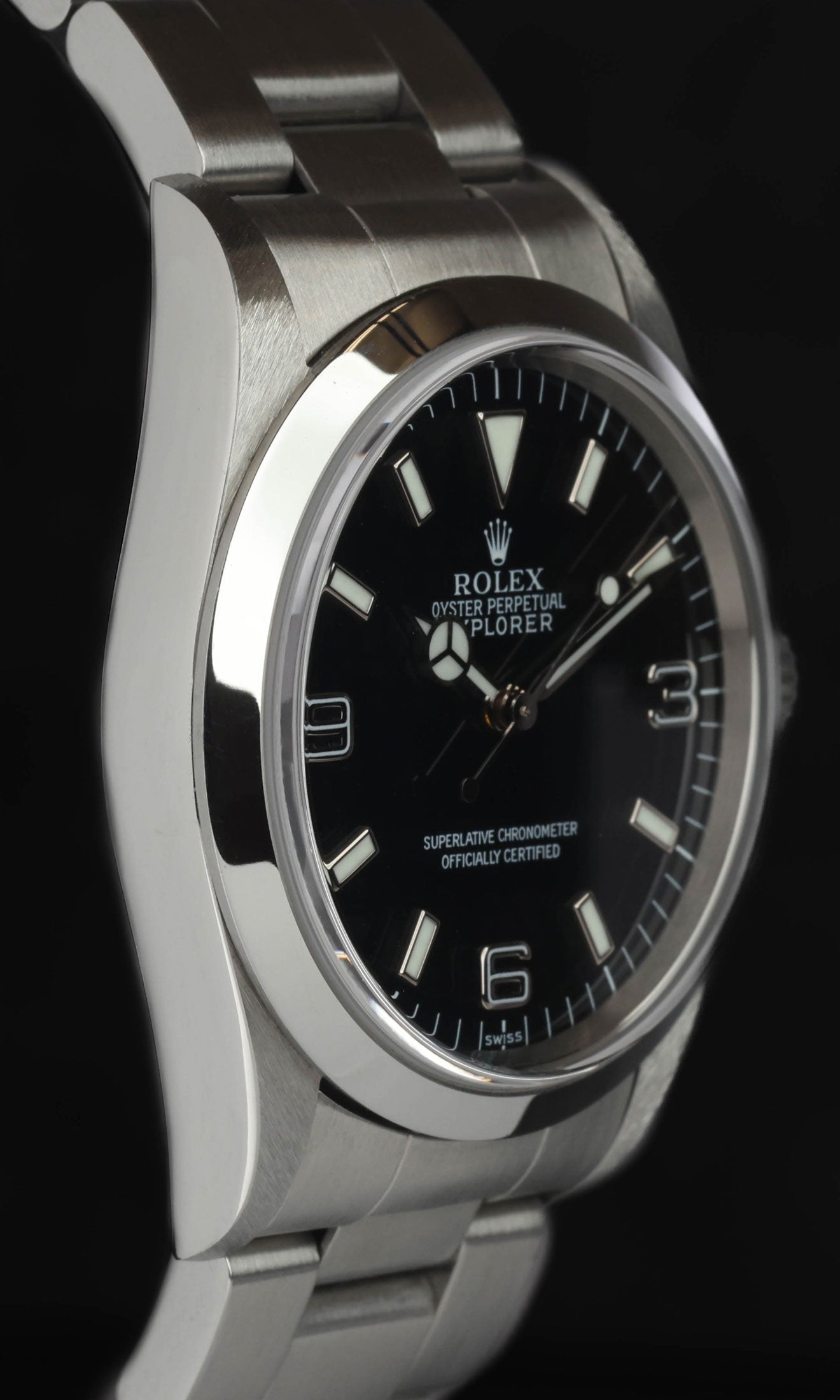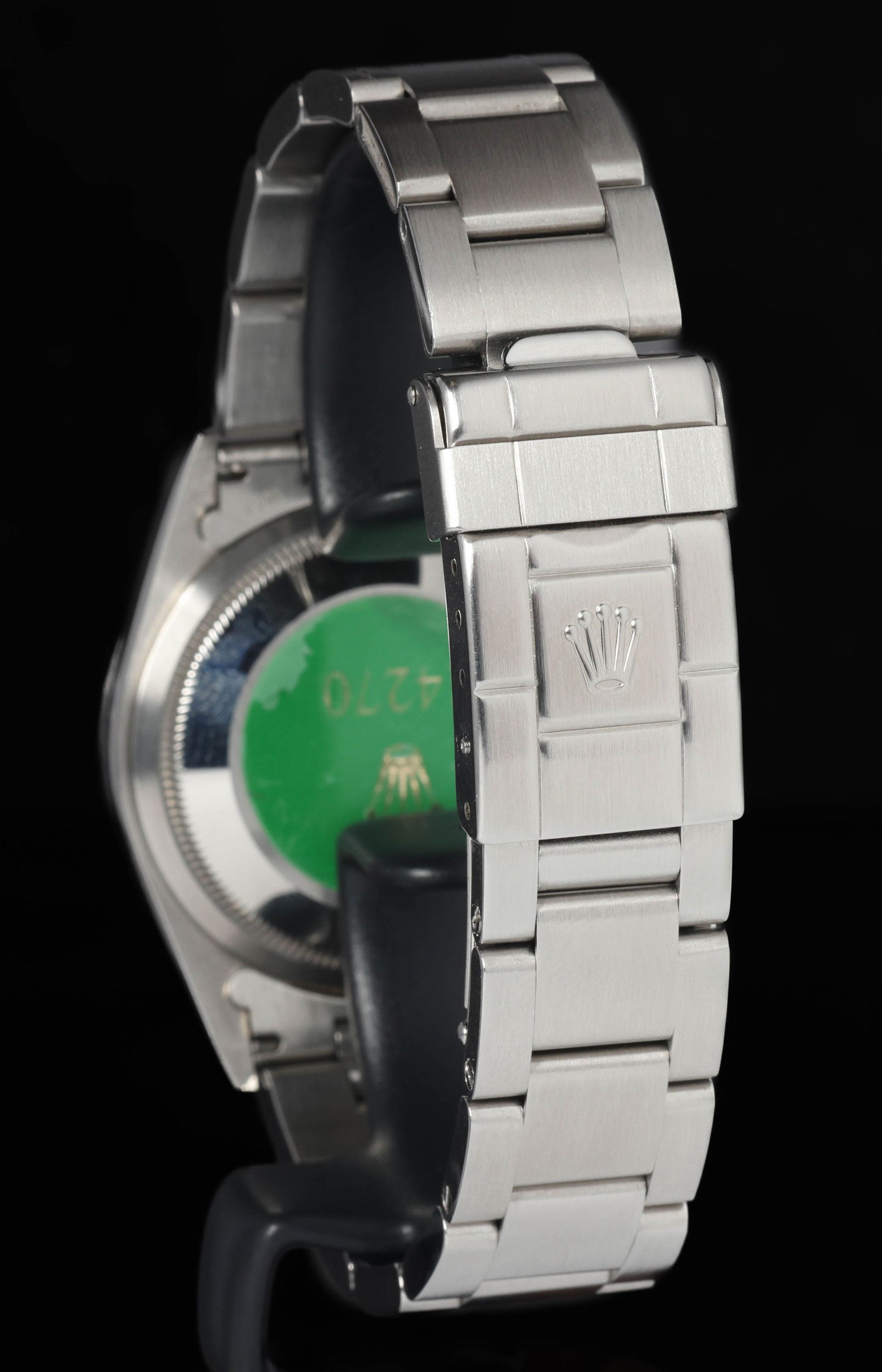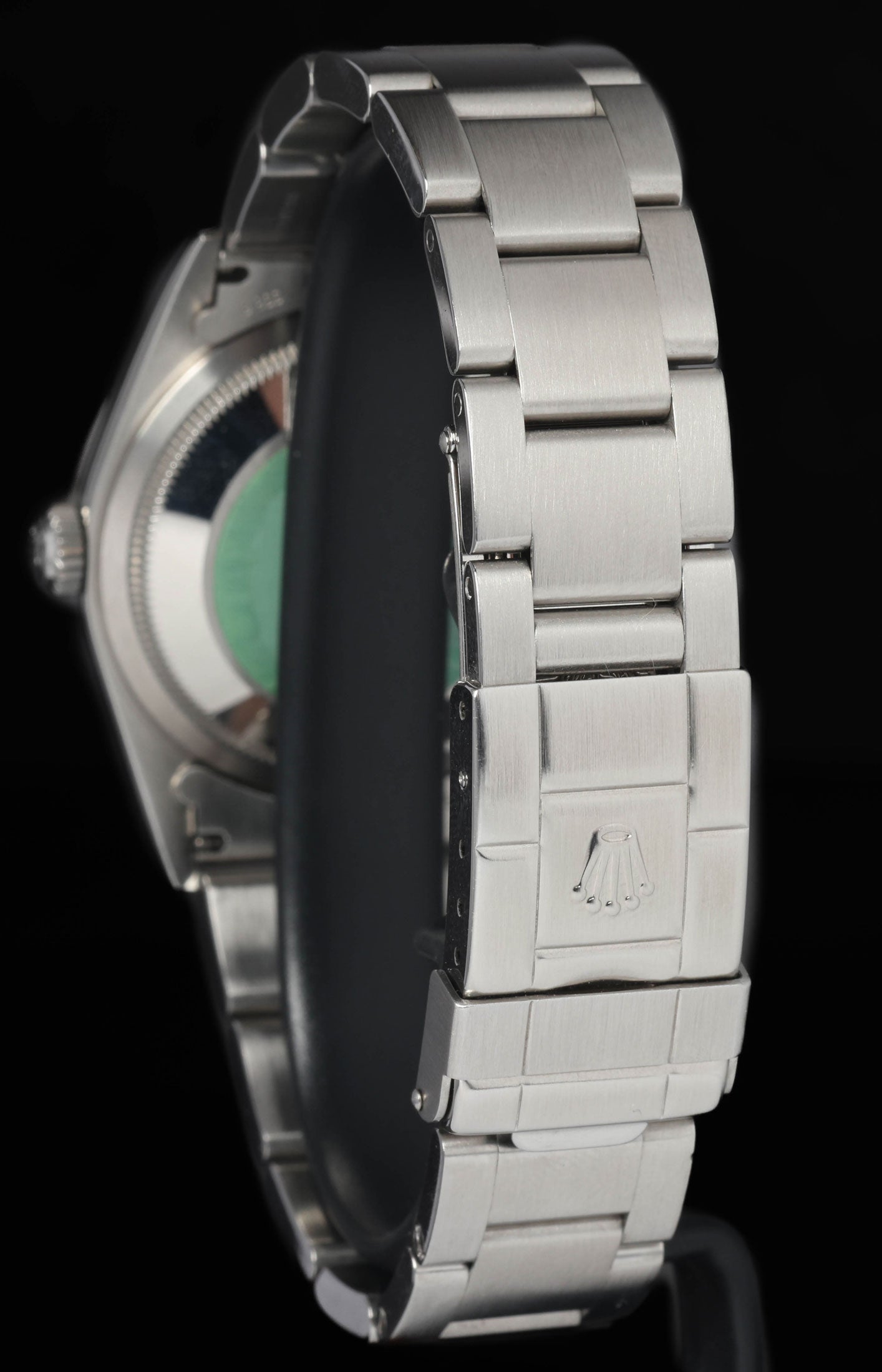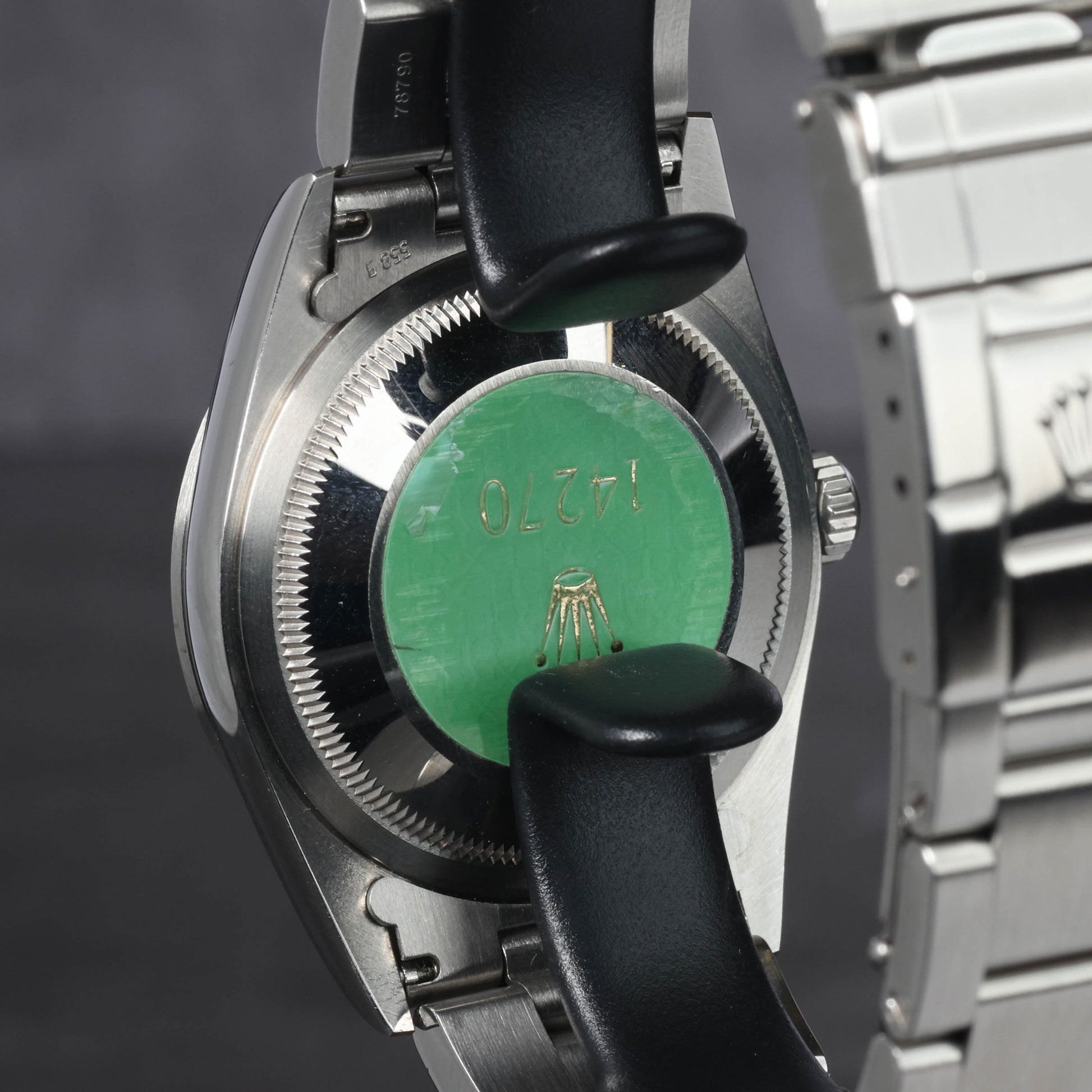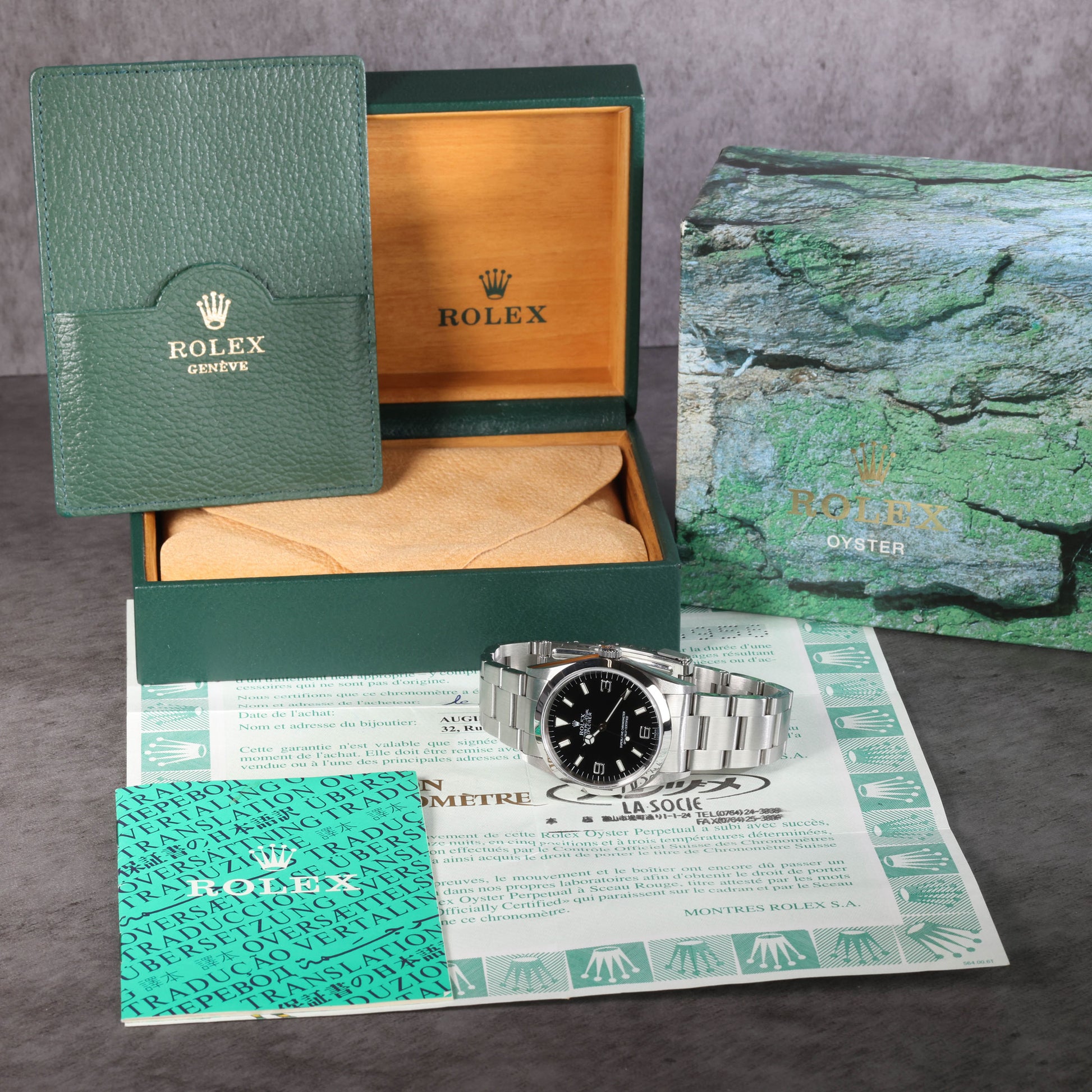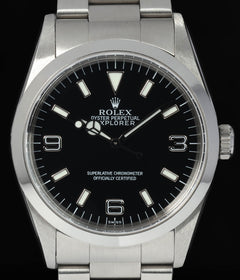Crown Vintage
Rolex Explorer I 14270 36MM 1999 | Box & Papers
Rolex Explorer I 14270 36MM 1999 | Box & Papers
Couldn't load pickup availability
Rolex Explorer I 14270 36MM 1999
Case and bracelet remain in very good overall condition, with only very light hairlines visible on the case flanks and lugs under close inspection. The watch presents as unpolished, with crisp lug lines and original factory brushing still evident across the case and clasp. There are no notable dings or distortions to the case geometry, and overall proportions appear strong and even.
The Oyster bracelet is in excellent condition with little to no stretch. Link articulation is smooth and consistent, the clasp closes securely with a positive snap, and the brushing is clean and in keeping with the unpolished status of the watch. End-link fit is tight at the case with no undue play.
Dial and hands are in excellent condition. The dial surface is clean with sharp printing and no visible marks or lifting, and the applied furniture presents evenly. Luminous material on the hands and hour markers is intact and well matched in tone, with strong, uniform appearance.
Overall, the watch presents as a well-preserved example with minimal wear, retaining its original finishing and a notably fresh dial and handset. It wears confidently on the wrist and reflects careful use.
Share
Why we love this watch
Why we love this watch
Rolex Explorer I 14270 (1999): The Neo-Vintage Bridge Between Classic and Modern
Overview
The Rolex Explorer I 14270 is where the stripped-back field-watch brief meets the modern Oyster formula. In a compact 36mm case with the hallmark 3-6-9 dial, it brings sapphire crystal, applied white-gold hour markers and a high-beat automatic calibre to a design that has prioritised clarity since the 1950s. Examples from this window often carry the succinct “SWISS” line at six o’clock, signalling the shift to non-radioactive luminous paint. The result reads clean and purposeful on the wrist, retaining the Explorer’s understatement while adopting contemporary materials.
Case and Dimensions
The case is a 36mm Oystersteel shell with a smooth polished bezel, flat sapphire crystal and screw-down Twinlock crown. Proportions are deliberately restrained: slim lugs, a compact mid-case and a low stance that slips under any cuff. Rated to 100 metres, it’s tough enough for daily wear without adding bulk. Drilled lugs suit quick strap changes and reinforce the neo-vintage character, while a 20mm lug width keeps pairing options simple. On the wrist, the watch feels light, balanced and secure—an everyday tool designed for timekeeping first.
Dial and Legibility
A glossy black dial sets a high-contrast stage for applied baton markers and the signature Arabic numerals at 3, 6 and 9 in white gold. Printing is crisp and minimal, and the absence of a date window keeps the minute track uninterrupted. The handset—Mercedes hour, straight minute and counterweighted seconds—is filled to match the dial’s luminous compound. Against the gloss surface, white elements pop in low light and daylight alike. The layout avoids gimmicks, relying on proportion and spacing to achieve instant legibility.
Lume Transition: From Tritium to LumiNova
A defining detail of this period is the move from tritium to non-radioactive pigments. Earlier dials read “T SWISS T” or “SWISS – T < 25”. During the changeover, the dial signature briefly became a single “SWISS”, before settling on “SWISS MADE” with Super-LumiNova. Practically, LumiNova and Super-LumiNova charge quickly and emit a green glow, while remaining a bright near-white by day. They age more slowly than tritium, which is why watches from this window commonly show even, stable lume without the warm patina associated with earlier dials.
Movement and Performance
Inside is Calibre 3000, a COSC-certified automatic movement beating at 28,800 vph with hacking seconds for precise setting and a power reserve of roughly two days. The architecture focuses on stability and efficient winding, delivering dependable accuracy in a compact footprint that suits a 36mm, dateless watch. Without a calendar mechanism to drive, the motion works stay uncluttered, and the movement’s higher frequency brings a smooth seconds sweep and robust timekeeping. It sits at an important point in the brand’s movement family—modern in rate and performance, yet sized for the classic Explorer silhouette.
Bracelet and Wearing Experience
The reference is typically paired with an Oyster bracelet: earlier examples often with 78360, later with 78790, each matched to period-correct end links and a simple folding clasp. Construction from this era keeps weight modest, which enhances all-day comfort. The bracelet tapers neatly, the clasp is low-profile, and the fully brushed links echo the case flanks for a cohesive look. On the wrist, the watch does not shout. The smooth bezel avoids glare, the gloss dial adds subtle depth, and the overall package wears close and secure—easy under a shirt, steady for travel, and unfussy day to day.
Historical Significance and the Explorer Line
The Explorer name emerged from a mid-century push to prove Oyster cases and self-winding movements in demanding conditions. Early references such as 6150 and 6350 laid down the blueprint: black dial, Arabic numerals, simple printing, and a case that could take a knock. The long-running 1016 refined that idea for decades with a matte dial, painted markers and acrylic crystal, becoming emblematic of a practical, legible field watch. The 14270 is the first Explorer to translate that heritage into a fully modern specification. Acrylic makes way for sapphire, painted plots become applied white-gold markers, and a high-beat calibre brings chronometer performance. Crucially, none of this disturbs the essentials: 36mm, dateless, black dial, and the 3-6-9 layout that ties every Explorer back to its origins. That fidelity is the point. Rather than chasing trends or decorative bezels, the 14270 demonstrates how a design can progress through materials and manufacturing while keeping its intent intact. It is the hinge between the tactile warmth of the 1016 era and the laser-etched, contemporary Explorers that followed, showing that modernisation did not require abandoning the watch’s purpose.
Early Variations: The “Blackout” and Transitional Dials
The reference isn’t a single, unvarying dial. Early production yielded the so-called “Blackout”, where the 3-6-9 numerals have black enamel centres rather than white. That look was short-lived, likely revised for legibility. The standard specification returned to white-centred numerals to match luminous plots. During the move away from tritium, the “SWISS”-only signature appears at six, linking the dial to the lume transition while preserving familiar fonts and layout. These small differences are typical of the period and help position a given example within the run.
A Lineage of Continuity
The Explorer’s strength is consistency. Through changes in crystal material, luminous paint and movement architecture, the core brief remains: clear time at a glance, robust case, restrained styling. The 14270 respects that lineage by updating the parts that improve usability—sapphire for durability, applied markers for clarity, a higher beat for precision—without touching the elements that define the watch. The continuity is not nostalgia; it’s a practical through-line that keeps the design relevant.
Model Evolution: Before and After
Set beside the 1016, the 14270 feels crisper: gloss lacquer adds contrast, applied indices give definition, and sapphire resists the scuffs that acrylic picked up in daily use. Its direct successor, the 114270, brings Calibre 3130 and incremental construction updates while retaining the 36mm footprint. Later, the 214270 explores a larger 39mm case and an early handset revision before the family returns to 36mm with the 124270. Across that arc, the 14270 stands as the first fully modern Explorer—proof that the formula could evolve without growing or complicating the design.
Case Construction and Details
Oyster Strength
The case architecture is quietly robust: a monobloc middle case with screw-down crown and caseback, and a flat sapphire crystal that keeps reflections manageable and resists scratches. The smooth bezel is not just a styling choice; without teeth or text, it’s less prone to dings and easier to keep clean, a practical fit for a daily-wear field watch.
Drilled Lugs and a Plain Rehaut
Lug holes do more than signal an era—they make strap changes quick and reduce the chance of slipping a tool against the case. The inner flange (rehaut) remains plain in this period, another cue that situates the watch in the neo-vintage camp, before engraved serial text became common. Together with the compact dimensions, these details deliver a design that feels timeless rather than time-stamped.
Identifying Period-Correct Details
For examples from this window, start at six o’clock: a single “SWISS” line indicates LumiNova before the later “SWISS MADE” wording. Hands and plots should match in both colour and glow characteristics—bright white by day, a green charge at night. Numerals at 3-6-9 present as white-centred within white-gold frames; if they appear black-centred, you’re likely looking at an early “Blackout” dial from the initial part of the reference’s run rather than the transition window. The case should show drilled lugs and a plain rehaut. On the bracelet front, 78360 appears earlier and 78790 later, paired with period-appropriate end links and a straightforward folding clasp. Clasp codes and caseback markings can help align parts to timeframes when viewed together.
Why the Size Still Works
The Explorer’s character is tied to its 36mm diameter. At this size, the negative space on the dial is doing as much work as the indices: the batons and numerals breathe without looking sparse, and the handset reaches the markers cleanly. Larger cases can push indices outward and upset those proportions; here the relationships stay tight, which is why the watch reads instantly at a glance. Thickness remains modest, the bracelet’s taper keeps weight centred, and the low profile avoids catching on cuffs or gear. It’s a practical, balanced package that wears well across a wide range of wrists.
Everyday Practicality
Day to day, the watch asks very little. The crown threads and seats smoothly, hacking seconds simplify precise setting, and the minute track is easy to read for quick timing by eye. The Oyster bracelet holds the case steady without hot spots, and the smooth bezel avoids glare under bright light. The design does not rely on colour accents or decorative text to feel purposeful; it is purposeful because it prioritises clarity and comfort. That’s the Explorer’s brief in action.
Final Thoughts
The 14270 carries forward the Explorer’s core ideas—clarity, robustness and restraint—while adopting the materials and movement performance expected of a modern Oyster. The transitional “SWISS” dial links it to a specific change in luminous technology, yet nothing about the watch feels experimental; it’s simply the classic 3-6-9 layout executed with contemporary parts. The case remains compact, the dial is free of excess text, and the movement delivers reliable chronometer timing without adding complexity. It is a straightforward, dateless field watch built to be worn every day. Look at the lineage before and after and the role of this reference is obvious. It is the bridge between matte-dial acrylic past and fully contemporary present, proving that evolution can be incremental, practical and respectful of purpose. If the aim is a time-only watch that vanishes until you need it—and reads clearly when you do—this Explorer gets that job done with minimal fuss.
Case & Bracelet
Case & Bracelet
- Case & bracelet in very good condition, very light hairlines visible on case.
- Bracelet in excellent condition, little to no stretch.
- Case & bracelet unpolished.
Dial & Hands
Dial & Hands
Dial & hands excellent.
Warranty & Condition
Warranty & Condition
Crown Vintage Watches provides a minimum 3-month mechanical warranty on pre-owned watches, from the date of purchase.
The warranty covers mechanical defects only.
The warranty does not cover damages such as scratches, finish, crystals, glass, straps (leather, fabric or rubber damage due to wear and tear), damage resulting from wear under conditions exceeding the watch manufacturer’s water resistance limitations, and damage due to physical and or accidental abuse.
Please note, water resistance is neither tested nor guaranteed.
Shipping and insurance costs for warranty returns to us must be covered by the customer. Returns must be shipped via traceable courier. Return shipment must be pre-paid and fully insured. Collect shipping will be refused. In case of loss or damages, the customer is liable.
Our Pledge
At Crown Vintage Watches, we stand by the authenticity of every product we sell. For added peace of mind, customers are welcome to have items independently authenticated at their own expense.
Condition
Due to the nature of vintage timepieces, all watches are sold as is. We will accurately describe the current condition and working order of all watches we sell to the best of our ability.
Shipping & Refund
Shipping & Refund
